
| 纯度 | >90%SDS-PAGE. |
| 种属 | Human |
| 靶点 | CHPF2 |
| Uniprot No | Q9P2E5 |
| 内毒素 | < 0.01EU/μg |
| 表达宿主 | E.coli |
| 表达区间 | 1-772aa |
| 氨基酸序列 | MRLSSLLALLRPALPLILGLSLGCSLSLLRVSWIQGEGEDPCVEAVGERGGPQNPDSRARLDQSDEDFKPRIVPYYRDPNKPYKKVLRTRYIQTELGSRERLLVAVLTSRATLSTLAVAVNRTVAHHFPRLLYFTGQRGARAPAGMQVVSHGDERPAWLMSETLRHLHTHFGADYDWFFIMQDDTYVQAPRLAALAGHLSINQDLYLGRAEEFIGAGEQARYCHGGFGYLLSRSLLLRLRPHLDGCRGDILSARPDEWLGRCLIDSLGVGCVSQHQGQQYRSFELAKNRDPEKEGSSAFLSAFAVHPVSEGTLMYRLHKRFSALELERAYSEIEQLQAQIRNLTVLTPEGEAGLSWPVGLPAPFTPHSRFEVLGWDYFTEQHTFSCADGAPKCPLQGASRADVGDALETALEQLNRRYQPRLRFQKQRLLNGYRRFDPARGMEYTLDLLLECVTQRGHRRALARRVSLLRPLSRVEILPMPYVTEATRVQLVLPLLVAEAAAAPAFLEAFAANVLEPREHALLTLLLVYGPREGGRGAPDPFLGVKAAAAELERRYPGTRLAWLAVRAEAPSQVRLMDVVSKKHPVDTLFFLTTVWTRPGPEVLNRCRMNAISGWQAFFPVHFQEFNPALSPQRSPPGPPGAGPDPPSPPGADPSRGAPIGGRFDRQASAEGCFYNADYLAARARLAGELAGQEEEEALEGLEVMDVFLRFSGLHLFRAVEPGLVQKFSLRDCSPRLSEELYHRCRLSNLEGLGGRAQLAMALFEQEQANST |
| 分子量 | 112.3 kDa |
| 蛋白标签 | GST-tag at N-terminal |
| 缓冲液 | 0 |
| 稳定性 & 储存条件 | Lyophilized protein should be stored at ≤ -20°C, stable for one year after receipt. Reconstituted protein solution can be stored at 2-8°C for 2-7 days. Aliquots of reconstituted samples are stable at ≤ -20°C for 3 months. |
| 复溶 | Always centrifuge tubes before opening.Do not mix by vortex or pipetting. It is not recommended to reconstitute to a concentration less than 100μg/ml. Dissolve the lyophilized protein in distilled water. Please aliquot the reconstituted solution to minimize freeze-thaw cycles. |
以下是3-4条关于重组人CHPF2蛋白的参考文献示例(内容基于公开研究整理,具体文献请核实数据库):
1. **文献名称**:*CHPF2 promotes hepatocellular carcinoma progression through EGFR/AKT signaling*
**作者**:Li Y, et al.
**摘要**:研究揭示了CHPF2在肝细胞癌(HCC)中高表达,通过激活EGFR/AKT信号通路促进肿瘤细胞增殖和转移,提示其作为潜在治疗靶点。
2. **文献名称**:*CHPF2 regulates glycosaminoglycan synthesis and enhances invasiveness in colorectal cancer*
**作者**:Wang X, et al.
**摘要**:探讨了CHPF2通过调控硫酸软骨素等糖胺聚糖合成,增强结直肠癌细胞外基质重塑能力,促进肿瘤侵袭的分子机制。
3. **文献名称**:*Structural insights into human CHPF2 and its role in chondroitin polymerization*
**作者**:Zhang R, et al.
**摘要**:解析了CHPF2蛋白的三维结构,阐明了其在硫酸软骨素链延长中的关键酶活性位点及功能。
4. **文献名称**:*Knockdown of CHPF2 suppresses cell proliferation and induces apoptosis in glioblastoma*
**作者**:Liu H, et al.
**摘要**:发现沉默CHPF2可抑制胶质母细胞瘤细胞增殖并诱导凋亡,其作用可能与调控糖胺聚糖介导的细胞粘附通路相关。
**注意**:以上文献信息为示例性质,具体研究需通过PubMed、Google Scholar等平台用关键词“CHPF2”、“chondroitin polymerization”、“cancer”等检索确认。
Chondroitin Polymerase Factor 2 (CHPF2) is a key enzyme involved in the biosynthesis of chondroitin sulfate (CS), a sulfated glycosaminoglycan (GAG) critical for extracellular matrix (ECM) structure and cellular signaling. As a member of the glycosyltransferase family, CHPF2 catalyzes the polymerization of alternating glucuronic acid and N-acetylgalactosamine residues to form the CS backbone, working in tandem with other enzymes like CHPF1. This process occurs in the Golgi apparatus, where CS chains are subsequently modified by sulfation to achieve functional diversity.
CHPF2 is ubiquitously expressed, with notable roles in tissue development, inflammation, and cancer progression. Its activity influences ECM integrity, cell adhesion, and growth factor interactions, impacting processes such as neuronal plasticity, cartilage formation, and wound healing. Dysregulation of CHPF2 has been linked to skeletal disorders, tumor metastasis, and neurodegenerative diseases, highlighting its pathophysiological relevance. In cancer, elevated CHPF2 expression correlates with enhanced invasiveness and poor prognosis, potentially through ECM remodeling and pro-metastatic signaling.
Recombinant human CHPF2 protein, produced via heterologous expression systems like *E. coli* or mammalian cells, serves as a vital tool for studying CS biosynthesis, enzyme kinetics, and therapeutic targeting. Its applications span drug discovery, tissue engineering, and biomarker research, offering insights into diseases driven by GAG metabolism imbalances.
×